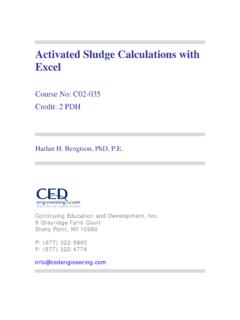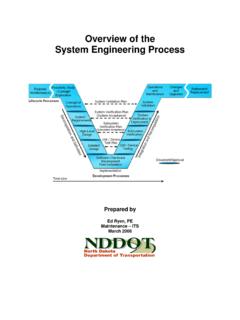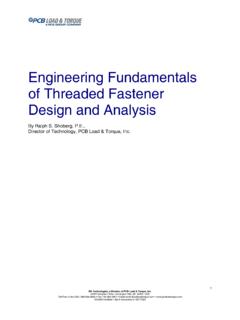Transcription of Design and Engineering Manual
1 Design and Engineering Manual January 2019 DISTRICT OF COLUMBIA DEPARTMENT OF TRANSPORTATION JEFFREY MAROOTIAN, DIRECTOR SAMUEL ZIMBABWE, CHIEF PROJECT DELIVERY OFFICER DAWIT MULUNEH, PE, CHIEF ENGINEER WASI KHAN, PE, CHIEF QUALITY ASSURANCE AND QUALITY CONTROL DIVISION DEPARTMENT OF TRANSPORTATION FEDERAL HIGHWAY ADMINISTRATION GOVERNMENT OF THE DISTRICT OF COLUMBIA DEPARTMENT OF TRANSPORTATION FOREWORD Washington, DC is a thriving and growing city with a rich history whose continued success relies on its transportation infrastructure. Our transportation solutions require engineered designs that are thoughtful of all users, contexts and the environments. The District of Columbia Department of Transportation (DDOT) Design and Engineering Manual was updated in 2017 and again in 2019 after not having been updated since 2009. This edition updates critical aspects of the Manual to reflect advances in industry guidance, provides information on topics that were not previously covered, eliminates inconsistencies and redundancies, and updates references and coordination with other DDOT manuals.
2 The transportation field is dynamic and continues to evolve, and therefore, this Manual will be updated on a recurring schedule to stay current. The users of this Manual will notice several meaningful improvements to key areas. For example, Green Infrastructure has been incorporated into a newly formed, comprehensive Drainage, Stormwater Management and Hydraulics chapter. Chapters on structures and geotechnical Engineering have been clarified and simplified, while new chapters such as Value Engineering , Project Deliverables, Bridge Load Rating Analysis and Reporting, and Intelligent Transportation Systems have been added. DDOT believes in fair and equitable transportation decisions for all of the traveling public and all users of the public space. DC is robust in supporting a variety of transportation infrastructure, public realm amenities, sustainable practices, and multimodal accommodations. We hope with this revision, engineers, designers and consultants find an improved resource at their fingertips to enhance the quality and livability for all residents and users.
3 We also value your feedback should you identify potential improvements or recommendations that may be considered during future revisions. Respectfully, Jeffrey M. Marootian Director Design and Engineering Manual i January 2019 Table of Contents PART I PROCESS AND PROCEDURES 1 Overview .. 1-1 Introduction .. 1-1 Authority and Applicability .. 1-2 Document Language .. 1-2 Definitions .. 1-2 Future Changes and Revisions .. 1-2 Policy Revisions .. 1-3 Technical Revisions .. 1-3 Governing Standards .. 1-3 Design Exceptions .. 1-4 2 Project Development .. 2-1 Introduction .. 2-1 DDOT Core Principles .. 2-3 Project Development Purpose and Objectives .. 2-5 Project Development Process .. 2-7 Step 1: Planning and Programming .. 2-7 Step 2: Environmental Approval and Preliminary Engineering .. 2-8 Step 3: Final Design .. 2-9 Step 4: Construction .. 2-9 3 Project Management .. 3-1 Design Team Structure .. 3-1 Risk Management.
4 3-1 Quality Assurance / Quality Control Plan .. 3-3 Quality Assurance Statement .. 3-4 Documentation .. 3-4 Independent Constructability Review .. 3-4 Post- Design Support Services .. 3-5 Major Project Considerations .. 3-5 3-6 ROW Acquisition and Clearances .. 3-7 Traffic .. 3-7 Structures .. 3-8 Materials for Pavement .. 3-9 Design and Engineering Manual ii January 2019 Drainage and Stormwater Management .. 3-9 Trees and Landscaping .. 3-10 Utilities .. 3-10 Agreement and Approval .. 3-10 Community Involvement .. 3-11 Maintenance Input .. 3-11 Bike/Pedestrian Improvements .. 3-11 Federal Lands Affected .. 3-11 Design Schedule Management .. 3-12 Preliminary Design Review (30 Percent) .. 3-12 Value Engineering .. 3-12 Intermediate Design Review (65 Percent) .. 3-12 Final Design Review (100 Percent) .. 3-13 Plans, Specifications and Estimates .. 3-13 Final Bid Documents .. 3-13 4 Agreements .. 4-1 Entity Agreements.
5 4-1 Utility Agreements .. 4-2 PART II - PROJECT DEVELOPMENT 5 Environmental .. 5-1 Introduction .. 5-1 Determination of Environmental Action Types .. 5-2 NEPA Action Types .. 5-3 EIS Action Environmental Impact Statement .. 5-3 EA/FONSI Action Environmental Assessment / Finding of No Significant Impact .. 5-4 CE Action Categorical Exclusions .. 5-4 DCEPA Action Types .. 5-5 Exemption .. 5-5 Environmental Impact Screening Form .. 5-5 Environmental Impact Statement .. 5-5 Environmental Process .. 5-5 Other Environmental Laws and Regulations .. 5-8 6 DDOT Design Phase Value Engineering (VE) Program .. 6-1 Introduction .. 6-1 Definitions .. 6-1 Value .. 6-1 Value Engineering in Design (VE Studies) .. 6-2 Value Engineering Change Proposals (VECPs) .. 6-2 Design and Engineering Manual iii January 2019 Applicability .. 6-2 Federally Mandated VE Studies .. 6-2 Non-Mandated VE Studies .. 6-3 Initiating a VE Study.
6 6-4 Team Structure .. 6-4 Team Leader .. 6-4 VE Coordinator .. 6-5 Consultant-Run VE Studies .. 6-5 VE Process/Methodology .. 6-5 7 Community 7-1 Step 1: Planning the Public Involvement Program .. 7-1 Step 2: Developing the Public Involvement Plan (PIP) .. 7-2 Step 3: Implementing the Public Involvement Program .. 7-5 Website Requirements .. 7-5 Print Material .. 7-5 Project Documentation .. 7-5 Step 4: Ongoing Evaluation and Modification of the Plan (as needed) .. 7-6 8 Rights-of -Way, Certification and Clearances .. 8-1 General .. 8-1 Overview of the ROW Acquisition Process .. 8-1 Determination of ROW Needs .. 8-3 Certification / Clearance .. 8-4 Relocation Assistance .. 8-6 ROW Changes .. 8-6 Permits/Rights of Entry .. 8-7 Federal Lands Acquisitions .. 8-7 Railroad Agreement Requirements for Right of Way Certification/Clearance .. 8-8 Basic Design Requirements for Railroad/Highway Projects .. 8-8 Other Documentation Generally Required for Railroad/Highway Projects.
7 8-9 Procedures that Generally Apply to Railroad/Highway Projects .. 8-9 Airport and Heliport Clearance .. 8-10 9 Utilities .. 9-1 Utility Clearance .. 9-1 Dry Utilities .. 9-1 Project Manager Responsibilities .. 9-2 Utility Company Responsibilities .. 9-2 Water, Sewer and Storm Sewer .. 9-2 Project Manager Responsibilities .. 9-2 DC Water Engineer .. 9-3 Subsurface Utility Engineering .. 9-3 Design and Engineering Manual iv January 2019 Subsurface Utility Engineering Overview .. 9-3 Policy and Standards .. 9-4 Quality Assurance Program .. 9-5 Utility Records Research (Quality Level D) .. 9-5 Utility Mapping (Quality Level C) .. 9-7 Utility Designating (Quality Level B) .. 9-7 Utility Locating (Quality Level A) .. 9-7 Other Facilities .. 9-8 Project Deliverables .. 9-10 Utilities Installed in Public Space .. 9-10 General Requirements .. 9-10 Location Criteria .. 9-11 Other 9-12 Utility Attachments on Bridges.
8 9-13 10 Drafting Standards .. 10-1 11 Control Survey and Topographic Mapping .. 11-1 Survey Requirements .. 11-1 Limits of the Topographic Survey .. 11-1 Topographic Survey Requirements .. 11-2 Topographical Features .. 11-2 11-2 Street Trees .. 11-2 Hydrologic Features .. 11-2 Building Outlines .. 11-2 General Field Survey .. 11-3 Survey for Bridges .. 11-3 Survey for Bridges over 11-4 Survey for Streams .. 11-4 General Requirements for Existing Conditions Plans .. 11-4 Accuracy .. 11-5 Drafting Requirements .. 11-5 Standard Abbreviations, Shading, Fonts and Symbols .. 11-5 Sheet Size .. 11-5 Readability .. 11-5 North Arrow .. 11-5 Graphical Scale .. 11-5 Bar Scale .. 11-5 Street Names .. 11-6 Survey Control Sheets .. 11-6 12 Project Deliverables .. 12-1 Project Deliverables .. 12-1 Design and Engineering Manual v January 2019 Submittals .. 12-1 Preliminary Engineering Report.
9 12-1 Discipline-Specific Reports .. 12-2 Preliminary Plan Submittal 30 Percent Review .. 12-2 Intermediate (Pre-Final) Plan Submittal 65 Percent Review .. 12-7 Final Construction Plans, Specifications and Cost Estimates Final Review .. 12-11 Plans, Specifications and Estimates Submittal .. 12-12 Final Bid Documents .. 12-12 Preparation of Drawings .. 12-13 Drawings .. 12-13 Organization of Drawings .. 12-13 Required Number of Plans .. 12-34 Cost Estimate Preparation .. 12-34 Bid History .. 12-34 Pay Items .. 12-35 AASHTO Estimator .. 12-35 Contingency .. 12-37 Special Provisions .. 12-37 Organization .. 12-37 Writing and Formatting .. 12-38 Reports .. 12-38 Report Guidelines .. 12-39 Preliminary Engineering Reports .. 12-39 Other Reports .. 12-39 Design Exceptions and Waivers .. 12-39 DDOT s Design Waiver Process .. 12-39 Design Exception Overview .. 12-40 FHWA s 13 Controlling Criteria .. 12-41 Non-Standard Design Features.
10 12-41 DDOT s Project Design Exceptions Processes .. 12-41 FHWA Approval .. 12-42 PART III - Engineering AND Design 13 Bridge Design , Rehabilitation and Replacement .. 13-1 Design Specifications .. 13-1 Materials .. 13-1 Structural Steel .. 13-1 Concrete Structures .. 13-1 Design Guideline .. 13-2 Bridge Geometrics .. 13-2 Bridge Type .. 13-5 Bridge Type, Size and Location (TS&L) Report .. 13-6 Design and Engineering Manual vi January 2019 Bridge Rehabilitation .. 13-6 Typical Rehabilitation .. 13-6 Additional Considerations .. 13-8 Field Condition Survey .. 13-9 Construction Staging .. 13-10 Bridge Rehabilitation Report .. 13-11 Bridge Replacement .. 13-11 14 Bridge Load Rating Analysis and Reporting .. 14-1 Methodology .. 14-1 Loads to Be Evaluated .. 14-1 Selection of Bridge Elements .. 14-2 Software .. 14-3 Load Rating Reports .. 14-3 Posting .. 14-4 Quality Control and Quality Assurance Process.

















